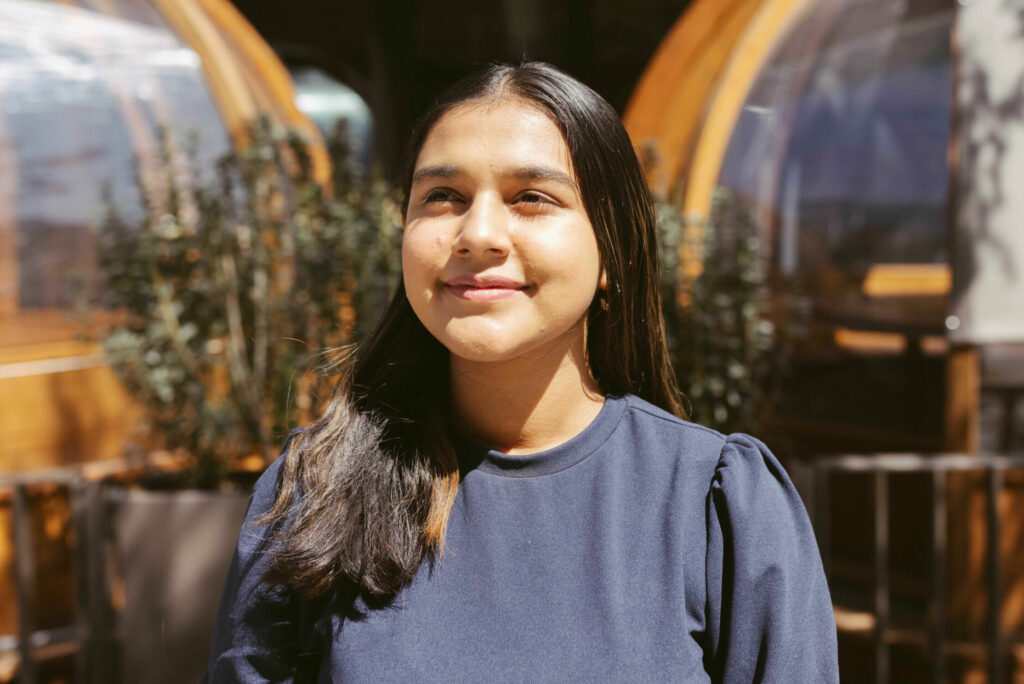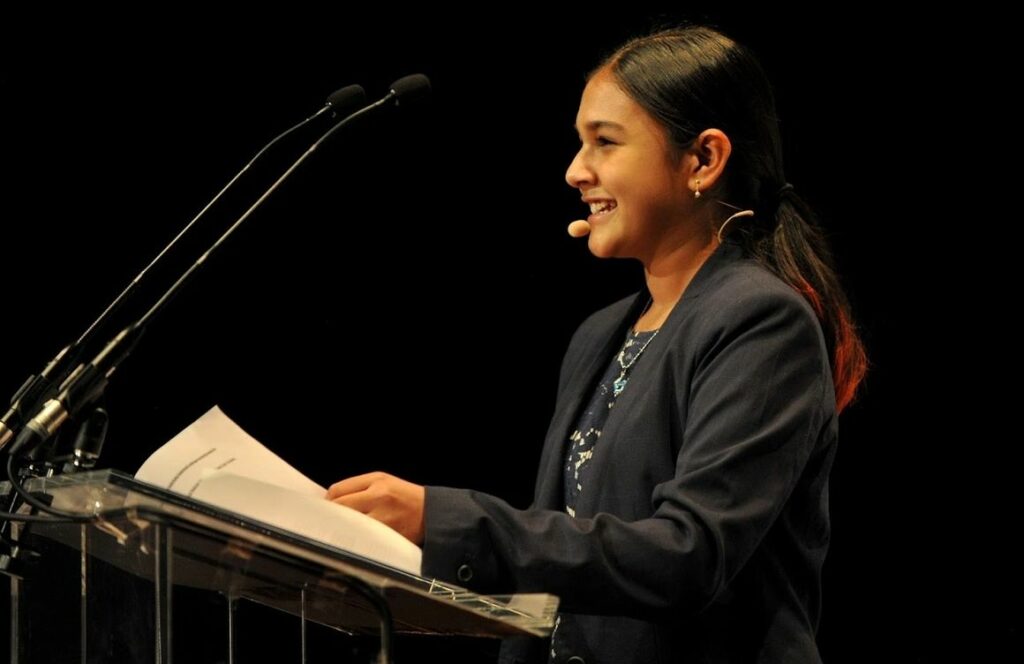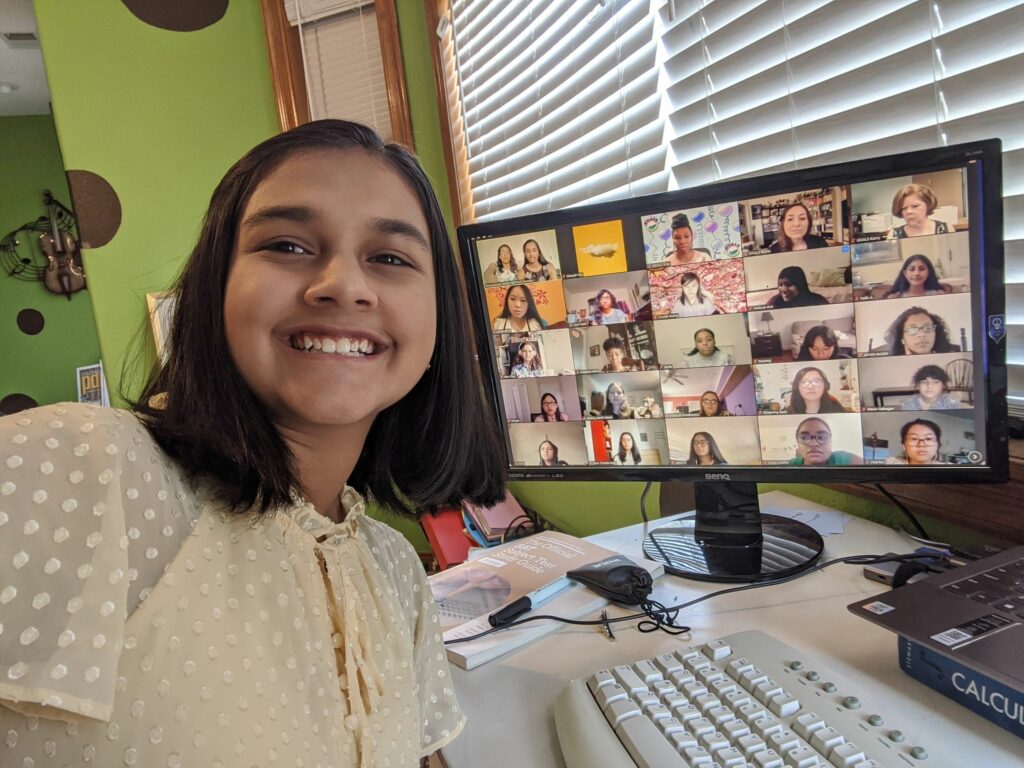
At only 16, Gitanjali Rao is a successful author, scientist and STEAM advocate, and has been on the cover of TIME magazine. The teenager sits down with Tech For Good to talk about how she is using technology to address the global challenges and inspire a new generation of young entrepreneurs.
There’s no minimum age to start making a mark in the world, and 16-year-old Gitanjali Rao is proof of that.
While most of her colleagues worried about their first day of high school, Rao was chosen among 5,000 nominees as TIME magazine’s first-ever Kid of the Year in recognition of her inventions. Her projects leverage technology to address global challenges ranging from water contamination to cyberbullying and the opioid epidemic.
Rao’s passion and determination come across even through video chat, as she explains her desire to build a community of young innovators that will work to make the world a better place.
“Everyone has the power to change the world,” she says. “They just need the passion to bring their ideas to reality.”
Over the last several years, Rao has been collecting awards for her innovative projects. She first rose to fame after winning the Discovery Education 3M Young Scientist Challenge and has since made the Forbes 30 Under 30 2019 list and was awarded Spotlight of the Year at Vogue’s Women Of The Year 2021. Although she is thankful for the recognition, Rao is most proud of her scientific projects and her ability to create change.
Rather than being the exception, Rao believes that she is the proof that anyone can make an impact in the world, no matter their age or background. Talking to Tech For Good, she reflects on some of her achievements and reveals what inspires her to continue researching new inventions.
“My passion for science has existed for such a long time,” she says. “I always looked at the world from a scientific approach, and then I started to look at how I could do something to improve it. I always wanted to put a smile on someone’s face and turned to science and technology to do so.
“I’m an innovator, author and promoter of STEM. And now, the CTO of the Future.”
With this title, Rao refers to the latest project she has been working on in collaboration with Lenovo. The company’s Kind City initiative has the vision to change urban environments forever. To do so, Lenovo has made a public call for people from all walks of life to share their vision of what a kinder city would look like. The responses to this prompt will then be curated using an AI and transformed into three founding principles that will inform a range of social initiatives. The project is the biggest crowdsourced public ‘census’ to imagine and co-author a blueprint for a city of the future built on kindness.

“We’re a well-driven mission towards helping create a more sustainable and kinder future for everyone right now and for future generations going forward,” Rao says. “I think it’s a really great cause. And, more than that, it really provides so many real-world stories. It honestly makes me jump out of my seat just thinking about the place that our world is in right now and how much more incredible it could be in the future with the latest technology that we have out there.”
Rao is taking part in this project as part of its ‘Kind Council’, a group of individuals from around the globe that are participating in an interactive podcast to discuss the fundamentals in achieving a Kind City. She’s definitely in good company, working alongside famous personalities like actor and activist Tan France and “the first human cyborg”, Dr Peter Scott Morgan.
As the Kind City Council’s CTO of the Future, Rao aims to promote STEM fields for women and kids all over the world and participate in discussions about inclusion, trust, sustainability and opportunities.
“With the Kind City project what I personally aim to do is continue spreading the importance of innovation and changing the world for the better,” she says. “It’s basically a blueprint of a city of the future. I think it’ll help us build a foundation that we can continue to build on as individuals, but also continue to grow as a community and help other people grow around us. I feel like it’s almost putting out there possibilities that we never thought were possible.”
Everyone has the power to change the world. They just need the passion to bring their ideas to reality
Kindness has long been a value that Rao has worked to promote. A couple of years ago, she created Kindly, a service that uses artificial intelligence and natural language processing to detect and prevent cyberbullying, under Microsoft’s guidance. The app and Chrome extension flags up terms and phrases that could be considered bullying and gives people the option to edit them before they get published online.
“What differentiates Kindly from other things out there is that it’s a non-punitive approach, meaning that it gives students the chance to re-evaluate what they’re saying before going directly to a punishment stage, which you don’t see in too many applications out there today,” Rao says. “I’m hoping that Kindly can help show how many children have the ability to change.
“One article I read said that it only takes seven seconds for any kid to change their mind about sending something that may not be nice, so giving students that chance to reevaluate things is very important. My goal is to create a safer and more positive future for everyone; one where we’re not fearing technology, but using it.”
Rao definitely has experience when it comes to leveraging technology for good. In addition to promoting values like kindness, one of her main areas of scientific interest has been improving the detection of contaminants in drinking water.
The teenager first got inspired to work in this field after the Flint water crisis, created after the city in Michigan switched its drinking water supply to the Flint River without adequate testing. Upon hearing about the health problems caused by the contaminated water, the then 11-year-old started working on designing a small, mobile device that was able to test for lead in drinking water using carbon nanotube technology. Rao 3D-printed the device to make sure it was small and affordable so people could use it daily at their homes.
“When I saw my mum using test-strips and sending our water off to the EPA [United States Environmental Protection Agency], I was shocked and didn’t think it was a reliable method,” Rao says. “I really wanted to do something to fix this, so that it not only helped my parents, but also Flint, Michigan, and places like this around the world.”
The design of the device earned Rao the title of America’s Top Young Scientist and marked her entry into the world of academic research. Now, Rao is continuing her work in this field by working on an inexpensive and accurate way of detecting biocontaminants in the water.

“I’m looking to detect parasitic contaminants in drinking water, using genetic engineered bioelectric sensors,” she says. “I am studying a specific parasite called cryptosporidium, which is very common in Africa and Asia, and trying to develop an easier, faster and more reliable way to detect it.”
But Rao’s collaboration with academia wasn’t restricted to water research. The teenager also collaborated with the University of Colorado’s Department of Cell Biology to find a solution for prescription opioid addiction using the latest innovations in genetic engineering.
Epione is designed to better understand how addicted a person is to opioids, a problem that causes 50,000 annual deaths in the US. Rao’s device automates the immunosorbent testing part of the traditional opioid addiction diagnosis process, allowing doctors to diagnose addiction earlier and improve how they monitor the condition.
“There were so many teens getting into prescription opioids, and, before anybody knew about it, it was too late to do anything,” Rao says. “I wanted to come up with a way to diagnose prescription opioid addiction at an early stage so you can take action earlier.”
With all these projects, there is no doubt that Rao is already a very successful scientist and is making a name for herself. Because of her projects, Rao has been able to have amazing experiences such as speaking in several global conferences and being a UNICEF panellist. Last year, she made a dream come true when she was interviewed by actress and activist Angelina Jolie for her TIME magazine cover article. Rao describes the experience as “absolutely incredible” and reveals that she is working with her team to organise workshops for the Maddox Jolie-Pitt foundation, which aims to support Cambodians as they develop their communities and protect their natural resources.
Rao’s age, ethnicity and gender make her look very different from the usual technology leaders. However, rather than it being something that sets her back, Rao celebrates her differences and hopes to use them to bring the views of her generation to a global audience. At the same time, her family and friends help her stay true to herself.
“Obviously, being 16, it’s weird for me to be put in that position,” she says. “I’m still doing chores every single day, and still going to school. I think that it’s easy to be pushed into the cloud so it’s always good to have someone to keep me grounded.
“But I think we have to recognise that our generation is growing up in a place where we’re seeing problems that have never existed before. nnovation in using technology isn’t an option anymore; it’s a necessity. And I’m excited to bring that to life with this city of the future.”
In order to inspire other people, and give them the tools they need to succeed, Rao has been running innovation workshops. So far, she has impacted around 55,000 students across 30 countries. In the events, Rao encourages every student to come up with an idea and a plan to make it a reality, with the goal of inspiring people to innovate in their everyday lives.
“With my workshops, I am aiming to share that each and every one of us can be innovators,” she says. “Each and every one of us has the power to change the world for the better. We need to put more role models out there to show that if I can do it, you can do it, and anyone can do it.”
However, Rao is aware that not everyone has access to the same resources and community support she had. In order to make her story more accessible, Rao has written a book, A Young Innovator’s Guide to STEM, that she hopes will reach children all over the world, and cover the material she can’t in her sessions, to share her story and motivation.
However, Rao is not only speaking to children. As a TEDx and UNICEF speaker, she uses her position in the spotlight to stress the role that companies and organisations have to play when it comes to educating the next generations and preparing them for the future.
“I was fortunate to have the support of the community at a young age, but not everyone is like me,” she says. “When I do speak to organisations I always end my talks with, ‘Don’t be afraid to go out and look for sponsorships, internships, mentorships and create friendships with students, because you do have the power to change the world’.
“We need to take into consideration everyone’s ideas, no matter which corner of the globe they’re from, no matter their age, gender or the colour of their skin. I’m a young South Asian woman who is speaking about science, you don’t see that very often. But I’m setting an example for everyone else who wants to do it now.”
Following in the footsteps of Greta Thunberg and Malala, Rao is joining the ranks of a new generation of young women who refuse to stay still in the face of global challenges. Her personal strength lies in her belief in the power of technology and her vision of a sustainable and kinder world powered by a new generation of changemakers. Rao is only one girl, but she is already inspiring thousands.



